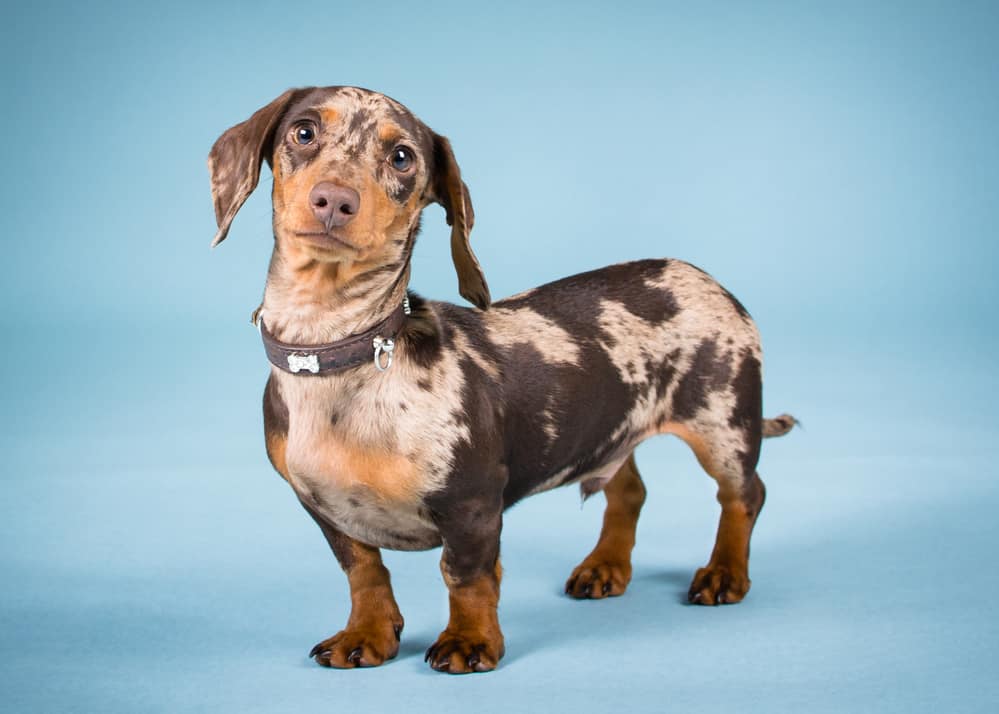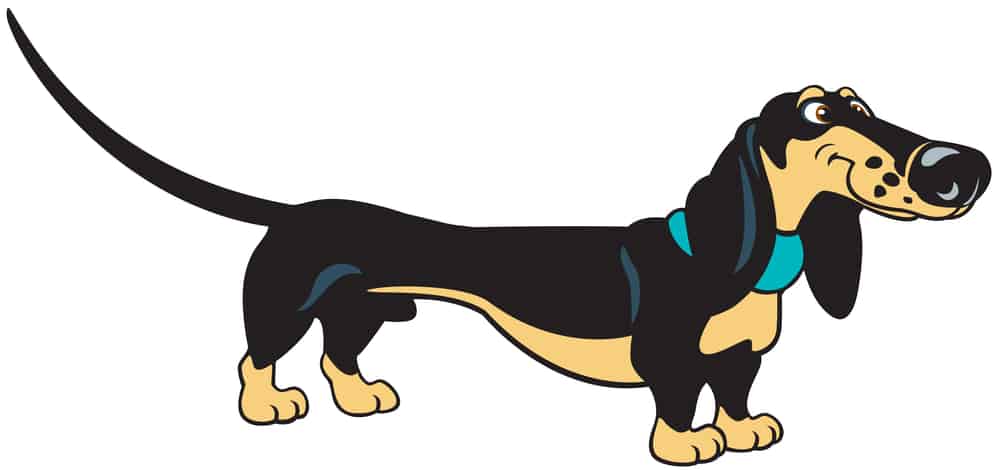How Long Do Miniature Dachshunds Live? What Health Concerns Do They Have?
“Wut Wut” was my first experience at owning a Miniature Dachshund. Though I had treated them for over 20 years as a small animal veterinarian, I had never experienced what it was like to own one. Her name was actually Coco. We called her the first name because that’s what she said to us all day long.
Curious, bold, and gregarious, the Miniature Dachshund is a unique and easily recognized breed of dog. Dachshund owners are near fanatical about their dogs and quite commonly own more than just one.
One of the most common questions I get from these owners are “How Long Will My Miniature Dachshund Live?” The answer to that question, based on information from the AKC (American Kennel Club) is 12-16 years.
I believe that Miniature Dachshund can routinely live to the upper end of this range and a little longer. In this article I will explain how to keep your Miniature Dachshund healthier so it lives to a very, very old age.

Table of Contents
How To Pick The Healthiest Miniature Dachshund Puppy
Having a healthy Dachshund starts first and foremost with picking the right breeder. There are two ways you can go about finding a quality breeder:
- Use the AKC site to find one
- Go through the Dachshund Club of America to find a reputable breeder
- If you’re not wanting an adult, check out a local Rescue!
- If you’re lucky enough to already know and love a Miniature Dachshund, find out who the breeder of the litter was. That’s a great start.
If you’re getting a Miniature Dachshund from a rescue organization, try to find out the medical history of the dog as completely as possible. Understand that, while problems can emerge at any time, chronic health conditions that have been dealt with (successfully or unsuccessfully) for years are going to be your responsibility going forward.
What Diseases Can Miniature Dachshund Suffer From?
Most people think of disc disease when they think of Miniature Dachshunds, but there are many potential health risks. Some of these include:
- Obesity
- Dental Disease
- Intervertebral Disc Disease (IVDD)
- Heart Murmurs
- Luxating Patella
Obesity
Miniature Dachshunds are prone to obesity because they are already so small to begin with. When you’re only 11 lbs., an extra half-pound can be way too much. Too much weight can make orthopedic issues (such as patella luxations or back pain) can be more apparent.
Getting Dachshunds to lose weight starts and ends with diet. In many cases, you need to start by reducing the volume of calories that your dog eats per day.
Note that I didn’t say volume of dog food. C’mon, we all love to give our dogs a little something extra at times. I’m not saying don’t treat your dog occasionally. What I am saying is that you’ll need to cut their overall caloric intake per day so, if you feed them a few treats, you’ll need to cut back on the regular diet instead. Consult with your veterinarian on how much you’ll need to cut back on your Doxie’s daily intake if they are obese.

If your Doxie loves to eat, you’ll likely need to put them on a low-calorie diet. For some Dachshunds, that means an OTC (over the counter) diet. I will usually tell clients just to use the low-calorie version of the dog food brand their dog is already on. That will minimize any problems changing their diet might cause.
For the most problematic obese dogs, a prescription diet such as Purina OM (Obesity Management) or Hill’s R/D (Reduction Diet) may be the only thing that can get your dog to lose weight. These high-fiber diets should only be used while your dog is trying to lose weight.
The unfortunate nature of dog foods on the market today is that the vast majority don’t put calorie totals on their labels. If you could compare one dog food’s caloric content per cup versus another, it would make it so much easier for pet owners to keep their dogs at optimal weight.
Diet is, by far, the most effective way of reducing your dog’s weight. Exercise helps, but it’s far more effective to cut calories. If you’re struggling to get your Dachshund to lose weight, consult with your own veterinarian. They may want to check some bloodwork to check the thyroid or use a prescription diet.
Dental Disease
Dental disease is the most common problem I see in my Miniature Dachshund patients. Some of it isn’t their fault. It’s a small mouth area and there’s a lot of teeth that have to fit in there. Do you own a Doxie? Look in their mouth right now and see the pre-molars that are actually situated almost perpendicular to the rest of the teeth.
Dachshunds have a hard time chewing due to the small size of their mouth so it’s hard for them to keep the plaque and tartar off manually. They also seem to be more genetically predisposed to acquiring more plaque and tartar than many other dogs.
Over time the tartar will work its way up the root of the tooth, pushing the gum away and causing the tooth to begin to loosen in the mouth. It’s highly unusual for a Dachshund in my practice to not lose teeth as they get older for this reason. When I acquired my own Dachshund, she was 15 years old and I had to remove many teeth due to the chronic disease that had been present in her mouth.
The best way to prevent tartar in your Dachshund will be to “brush” their teeth daily. By brushing, all I mean is to put a bit of dog-specific toothpaste on your finger and then rub that toothpaste along the outside part of your dog’s teeth. You don’t need to force the mouth open. In fact, it’s easier and faster if they hold it closed.
You’ll likely need to start getting your little Doxie used to this as soon as you bring their home the first time as they are quite stubborn and will be difficult later in life to train for brushing. In any case, in a perfect world, do this daily and it’ll only take you about 15 seconds total. Get as close to perfect as you can.
IVDD
IVDD is a degenerative condition in which the cartilage that makes up the discs in the spine become inflexible and brittle over time. This makes them more likely to tear and bulge up into the area of the spinal cord. This causes some pretty significant pain and, when it’s really bad, loss of your dog’s ability to use its legs.
While there are medications that can help in many occurrences of IVDD, there are times when only surgery can help your dog. Unfortunately surgery for IVDD is very expensive ($3,000 – $7,000 at minimum; more if there are complications) and doesn’t guarantee your dog’s full return to normal mobility.
Heart Murmurs
Miniature Dachshunds quite commonly have heart murmurs that begin to be audible at anywhere from 7-12 years of age. I often feel (no evidence, just my experience) that the younger a Dachshund shows a heart murmur the more likely they’ll progress to congestive heart failure one day.
The murmurs result because of abnormal blood flow within the heart due to malfunctioning heart valves. The valves open and shut to help blood move from one compartment of the heart to the next. When a valve becomes too thickened and brittle, it can lose the flexibility that is needed to provide a solid closure to that chamber of the heart.
The resulting sound of the blood moving around the valve is what’s heard in the murmur. Because of this “backward” blood flow, pressure can build up in the heart and ultimately cause changes in the heart size and the buildup of fluid in the lungs (congestive heart failure) or in the abdomen (ascites).
Not every dog that develops a murmur will require attention. Xrays can help to identify if the heart is changing size or a cardiac ultrasound can be used to look even deeper into the heart to pinpoint changes in blood flow and pressures.
Patellar Luxation
This is a condition in which the kneecap (it can be just one knee or both of them) doesn’t sit properly in the groove of the femur. Doxies are prone to this condition because their leg bones are frequently very curvy.
That curve in the leg puts a lot of stress on the side of the knee and, over time, there’s pressure for that kneecap to move medially (towards the other leg). In some dogs the kneecap will freely move from a very young age (as early as 4-6 months) whereas in other dogs it comes on over time as they age.
The luxation can freely move in and out of position or it can move out (luxate) and then get stuck. The more problems this luxation causes, the more likely that only surgery will fix it.
How Can I Get My Miniature Dachshund To Live Longer?
Healthy Weight
There is no “magical weight range” for a Miniature Dachshund. Each dog is different and their optimal weight will vary based on their height and the amount of muscularity. Typically you should feel or see an hourglass shape when touching or looking at your Miniature Dachshund from above. Bigger chest, narrower waist.

Miniature Dachshund that are overweight will be less likely to exercise and more likely to develop back problems as they age. The longer this is allowed to go on, the more likely that your dog may suffer from a very painful disc bulge/rupture.
If your Miniature Dachshund is overweight, and you can’t get the weight off with reducing their diet, have a thyroid screen done. A hypothyroid dog can not lose weight unless they get proper thyroid supplementation.
No Jumping!!!
It’s not really the jumping up that gets Dachshund’s back. It’s the jumping back down and hitting the ground with their short little legs that radiates all the force of the impact up through their back and neck. Don’t let them jump up onto couches or other furniture, either! Why? Because then they just jump back down!
By far the best way to manage this issue is by getting them a ramp and training them to use it. The ramp below is my favorite because it forces the dog to stop at the top of the ramp and turn to go down. Dachshunds have a tendency to barrel around in a straight line when possible and this ramp will at least slow them down a little at the beginning.
Good Dental Health
This is where you can make the most difference in your Miniature Dachshund’s health. It’s going to be difficult at first to introduce your dog/puppy to having their teeth brushed. However, with patience and time, any dog can learn to adjust to having their teeth brushed.
If, after all else has failed, you simply can’t apply toothpaste to your Miniature Dachshund’s teeth, then at least make sure they are getting a professional teeth cleaning at your veterinarian’s office when they need it.
Preventative Medicine/Wellness Exams
I’m a veterinarian so of course I’m going to tell you that regular wellness exams at the vet is extremely important. A good vet can spot conditions sometimes earlier than even the most dedicated owner can.
When your Miniature Dachshund reaches 5-6 years of age, there are two things that you should consider doing:
- If you haven’t already had it done, have the vet run some bloodwork to check out all the internal organs. Primarily we are screening for kidney and liver disease, but there are literally hundreds of disease conditions that can be picked up by basic lab tests. Start doing this every year to catch issues early.
- If there’s any level of dental disease and you haven’t already had a dental cleaning done, do one now. It will hopefully get ahead of more chronic issues down the road.
In The End
I think every Miniature Dachshund should have a good chance to live a good, long life. 14-16 years should be doable for just about any dog. Our own Dachshund made it to 18 years despite living with no teeth for the last few years of her life. Hopefully yours will be this fortunate.


One Reply to “How Long Do Miniature Dachshunds Live? What Health Concerns Do They Have?”
Comments are closed.